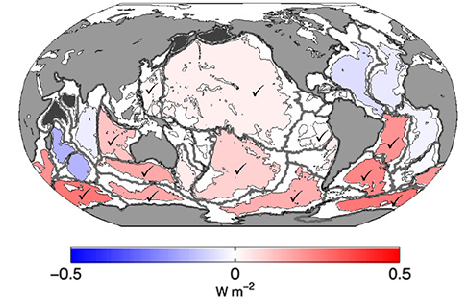
Basin-averaged 1991–2010 warming rates (expressed in W m-2, see colorbar) for the abyssal ocean (4000–6000 m) estimated using data from repeated high-quality, full-depth, coast-to-coast global surveys of ocean water properties. Check marks indicate basins in which warming rates are statistically significantly different from zero
Desbruyères, D.G., S.G. Purkey, E.L. McDonagh, G.C. Johnson, and B.A. King (2016): Deep and abyssal ocean warming from 35 years of repeat hydrography. Geophys. Res. Lett., 43, 10356–10365, doi:10.1002/2016GL070413.
Decadal repeats of high-quality, full-depth, coast-to-coast global surveys of ocean water properties have been revisited since the 1980s. These surveys were completed first under the auspices of the World Ocean Circulation Experiment, then CLIVAR/CO2, and now GO-SHIP. The data from these surveys provide global ocean observations below the 2000-meter sampling limit of core Argo floats. Evaluation of deep warming trends below 2000 m using these highly accurate (±0.002°C) survey data yields an estimate of a net heating rate of 33 ± 20 TW (1 TW = 1,000,000,000,000 Watts) from 1991 to 2010, which is about 10% of Earth’s energy imbalance over the last decade. The highest warming rates are found in the abyssal layer (4000–6000 m) around the Southern Ocean, from whence Antarctic Bottom Water spreads into the rest of the abyssal global ocean. The global warming rate below 2000 m did not significantly change from the 1990s to the 2000s, but significant regional variability occurred.
For more information or to read the full article, visit the publisher's article page here.


